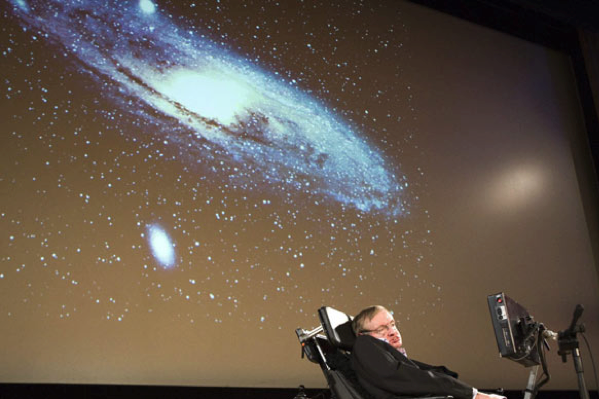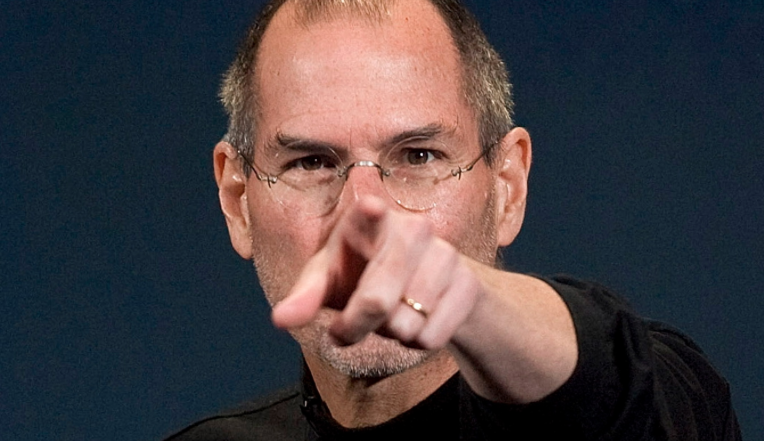On the 8th of January 2013, the day of Hawking’s birthday, I published an article in Wired Magazine about Stephen Hawking. The article was immediately picked up and praised by the Dish, Andrew Sullivan’s famous blog, among whose fans ranks President Obama. The praise, however, didn’t last long. The Daily Mail, a national British Tabloid, jumped on the article, and transformed me into a monster attacking a national hero with a severe disability. What a wonderful target I was, a woman, French (we know how the French and the British get along), and living in America. The article in The Daily Mail went viral. I was stunned by the extreme reaction, by the (intentional?) misinterpretation by the journalists, and by what the anonymity of the web allows: the violence and the cruelty of the emails I received were astonishing. I had touched a nerve, or multiple nerves. I had touched the myth of our modernity, so beautifully incarnated by Stephen Hawking, the idea that a man alone, unable to speak and move, was able to reach the ultimate laws of the universe with nothing but the strength of his reasoning.
Indeed, science is always portrayed as being the product of pure and beautiful minds and by showing that a complex nexus of humans and machines allowed Hawking to think, I was greatly destabilizing both the image of the hero and how science functions. Don’t get me wrong, I love science and technology and I deeply admire Hawking, but I think it is time to change our way of thinking about science, technology, and the notion of genius and the individual.
Today it is commonplace to say that science (and technology) is at the core of our society, slowly reconfiguring our ways of thinking, producing knowledge, interacting, trading, socializing, and loving. It is either praised (a land of promises), or attacked (when it is entangled with economic goals), but never really questioned. That is, it is taken for granted and at face value. But how do scientists do what they do on the ground and in daily life? Why is science put on a pedestal? Where does its authority come from? And why does it matter to know this?
I belong to a cohort of anthropologists, sociologists, and historians of science who have decided to follow scientific controversies, and open the door of laboratories to answer this question. Too often, this practice/discipline has been understood as an attack on science; but it is not. It is just a way of fleshing out, revitalizing, and showing all the complex social and material ramifications that allow science to function. Indeed, science in the making is fascinating to study. It is in no way cold and detached, rather it is intimately entangled in our social fabric. So, why does the myth of the solitary genius producing science only with his mind always resurface? Is my discipline wrong? Hawking intrigued me for this very reason: he is indeed the incarnation of the genius and he represents the power of the mind over the body.
I thus embarked on an in-depth ethnographic study that lasted 10 years. I interviewed and observed Stephen Hawking, but also his assistants, students, colleagues, and nurses, the engineers who built the computers he relies on, the journalists who wrote about him, the archivists who collected the traces of his presence, and the artists who represented him. My questions were simple: How is it possible to travel and give talks all over the world when it is so difficult to move? How can you write a scientific article and mobilize information when you can’t go quickly to the library, have small talk in the corridor, or pick up a journal? How can you resolve mathematical equations when you can’t write, scribble, or get up and write equations on a blackboard? How can you give an interview when it takes so long to respond to a question? How can you work an audience when you can’t harangue a crowd? Can all of this be the product of a mind alone, as our Western conception of an individual has led us to believe? In trying to answer these questions, I began to reconstruct slowly what I call Hawking’s extended body—a body composed of his assistants, his computers, and his students, et. al. I tried to understand what they do, how they communicate with him, what kind of information goes through the machine and what is negotiated face to face. What indeed does Hawking do himself and what kinds of competences are attributed to him?
To my surprise, the one who encompassed the entire universe in his mind could “do” very little. Because of his disability, everything “he does” has to be delegated to machines and human beings that do most of the work: the Personal Assistant is in charge of the media, travel, emails, and public requests; the Graduate Assistant takes care of the machines he uses, makes phone calls, updates the website, books the plane tickets, prepares images and diagrams, ensures the transportation and coordination of Hawking/machine/voice from one point of the planet to another while also taking care of the journalists; the computer gives Hawking the words to write articles and conference papers and the ability to respond to questions; the synthesizer gives him a voice; the students draw diagrams, calculate and resolve equations, and write and extend Hawking’s ideas; the nurses take care of all his physical needs; and so on and so forth. All these actors are visible or disappear depending on the situation. And, all these actors (even the computer) act on a twitch of a cheek. This is the paradox I explored in my ethnographic study. I traced and made visible the coordination and articulation of complex collective bodies composed of humans and machines that produce—and indeed, are—an individual. Thus, if Hawking has a body, he also has a multiplicity of collective bodies of which he is at once an element and a product: this is why I titled my book Hawking Incorporated.
Where is “he” then? Paradoxically, I showed that it is because his intellectual competences, his identity, and even his own body, are more distributed, collectivized and materialized than those of any one else, that he is the most singular of all. In other words, the more powerful you become, the more infrastructure you need, and the more infrastructure you get, the more you seem to stand alone. This is the paradox of the “distributed-centered subject,” as I called him. This is the image of the president framed by the window of the oval office, alone, looking at the distant horizon, after the crowds of advisors have evaporated.
Or the manager leading his group by a simple yes or no;
or the celebrity on stage perspiring under the spotlights that leave the backstage—and the constant collective effort that made her entrance possible—in darkness:

And indeed, it helps us rethink differently the genius.
Let’s try again. Is everything in Hawking’s mind? No, of course, pretty much everything is outside his mind, made and remade by things and others around him. Is he a pure social construction, a fraud? Of course not, he is, rather, entirely nourished by this network that he conversely nourishes. Is he a product of all these associations? Yes, but also much more than this. Indeed, his case helps us rethink the dichotomy between individual and collective, actor and system. Thus we can’t talk anymore about the individual versus the collective, the individual against the collective, or the self made man, for we see that an individual is a collective. Yes, we need to reconceptualize our conception of the individual. A man that is cut out, detached, and isolated becomes less than an individual, disappearing on the surface of the pavement. A man that is collectivized, and more so than others, is the most singular, and therefore stands out the most. He is an individual fully fleshed.
The notion of the “distributed-centered subject” emerged when I conducted an ethnographic study in 1992 in a major French oil company (Elf Aquitaine now Total).
Fascinated by what it meant to innovate in a large multinational corporation structured by strong organizational and technical constraints, I focused on an individual considered to be extremely creative. In my book, L’Entreprise Créatrice (English edition under review at Duke University Press), I described how research scientist François Montel distinguished himself through the creative skills he applied in formulating working instruments (new models to simulate petroleum fluid), organizational structures (the creation of a new center inside the company) and human relations (the capacity to emulate a creative working environment). I argued that the more this actor was linked up with his institution, his objects of research, his co-workers, and so on, the more potential he had to become inventive; and the more inventive he became, the more he seemingly distinguished himself as an inventor, as a kind of genius who existed beyond social, material and cultural constraints. It is, I argued, by simultaneously “identifying with” his object of research, personifying his institution and empathizing with the needs and interests of his colleagues that he was able to invent. By placing himself at the intersection of different research fields, he was able to translate problems from one field to another, and thus constantly feed his inventive mechanism and his status. By consolidating his group from the inside—that is to say, by making it participate in the creation and by delegating to it his know-how—he extended his recognition. By locating the computer programs he had invented in different phases of interpretation of oil fluid, he spread out his action. By placing doctoral students—whom he would eventually bring back to his lab—in well-known research laboratories, he gave himself the possibility of fuelling his theories with new information and also spreading his field of influence.
In short, it was because Montel positioned himself, in several places in order to occupy different spaces, that he was able to feed his know-how, maintain himself at the center of the network that he created, and enhance his recognition. He can be distinguished from this network precisely because he moves within it in a specific way, mixing with his research object, and translating and linking up things which were previously unconnected. Indeed, in the case of Montel, the presence of the inventor’s body was indispensable to understanding how certain properties were exchanged and how an innovative process functioned. Stephen Hawking, similarly, seems more like the inventor working in a firm with a thousand other persons than the solitary scientist he is usually described to be. Moreover, he is even more distributed than François Montel insofar as his inability to make his own body work has allowed numerous operations, normally embodied in a single “abled” person, to become visible for the ethnographer, because they are externalized and incorporated in other bodies. In other words, he is not an exception; rather, he makes visible what we normally don’t see.
What would happen, then, if we began to think about ourselves, or to represent ourselves, not as individualized disincorporated brains, but as subjects materialized and distributed in a series of overlapping and interconnecting collectivities—that is, as “distributed-centered subjects”? What would happen to our conception not only of the scientific genius, but also of the artistic genius, of the political leader, of the entrepreneurial manager, or the CEO? What would be the impact on our ways of presenting ourselves to other cultures, on our ways of rethinking the distinction between the worker and the leader, the chief and the assistant, the humans and the machines? What would be the significance for this way of approaching the individual for thinking about how we establish salaries and distribute rewards; think about authorship and imagine collaboration; design machines; and more prosaically, how we navigate the world? These questions are at the core of a long-term program of research I propose to explore. I believe they can only be answered on the common ground where philosophy, ethnography, and industrial concerns meet.





0 Comments